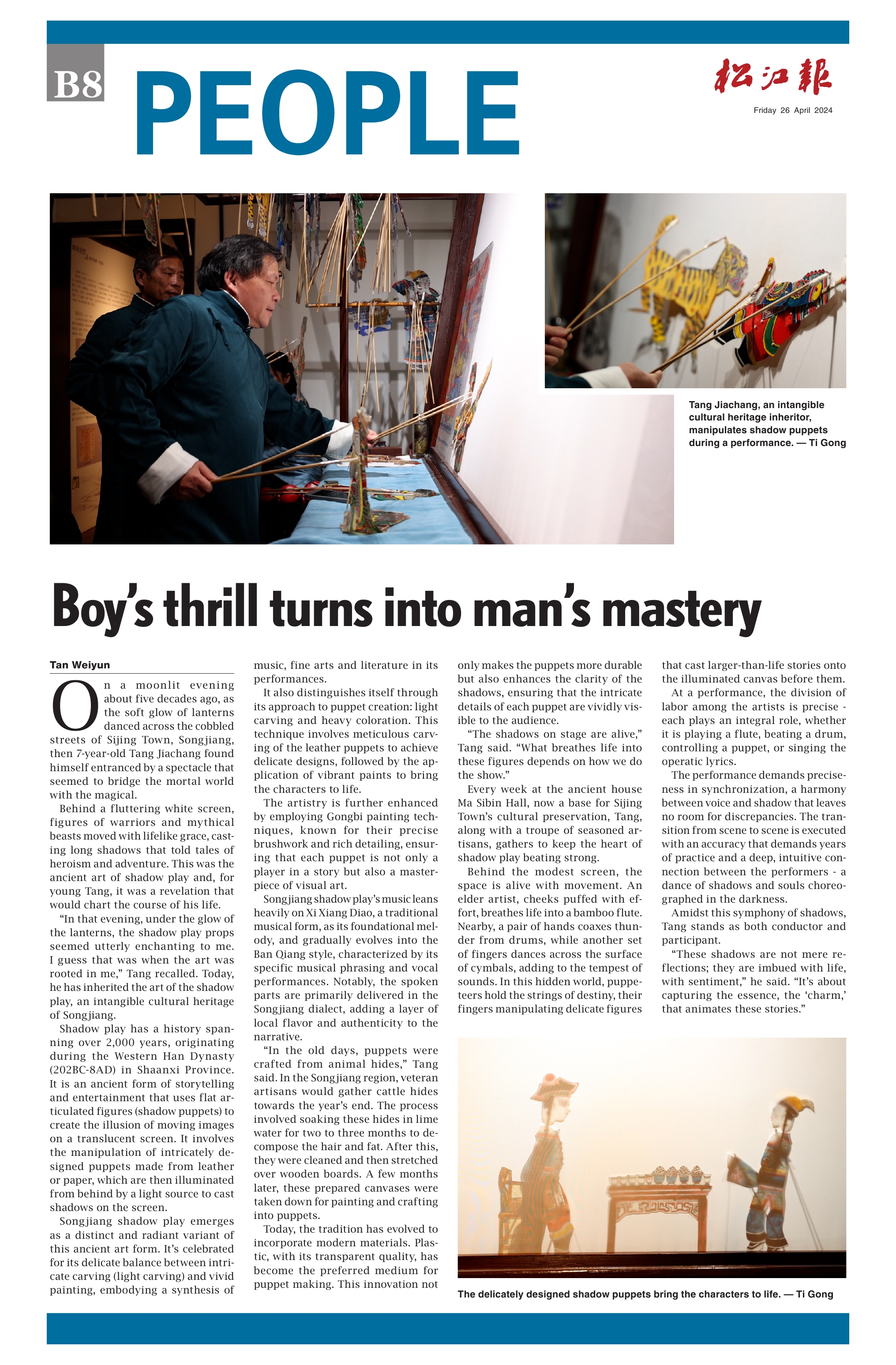

Boy’s thrill turns into man’s mastery


Tang Jiachang, an intangible cultural heritage inheritor, manipulates shadow puppets during a performance. — Ti Gong
Tan Weiyun
On a moonlit evening about five decades ago, as the soft glow of lanterns danced across the cobbled streets of Sijing Town, Songjiang, then 7-year-old Tang Jiachang found himself entranced by a spectacle that seemed to bridge the mortal world with the magical.
Behind a fluttering white screen, figures of warriors and mythical beasts moved with lifelike grace, cast-ing long shadows that told tales of heroism and adventure. This was the ancient art of shadow play and, for young Tang, it was a revelation that would chart the course of his life.
“In that evening, under the glow of the lanterns, the shadow play props seemed utterly enchanting to me. I guess that was when the art was rooted in me,” Tang recalled. Today, he has inherited the art of the shadow play, an intangible cultural heritage of Songjiang.
Shadow play has a history span-ning over 2,000 years, originating during the Western Han Dynasty (202BC-8AD) in Shaanxi Province. It is an ancient form of storytelling and entertainment that uses flat ar-ticulated figures (shadow puppets) to create the illusion of moving images on a translucent screen. It involves the manipulation of intricately de-signed puppets made from leather or paper, which are then illuminated from behind by a light source to cast shadows on the screen.
Songjiang shadow play emerges as a distinct and radiant variant of this ancient art form. It’s celebrated for its delicate balance between intri-cate carving (light carving) and vivid painting, embodying a synthesis of music, fine arts and literature in its performances.
It also distinguishes itself through its approach to puppet creation: light carving and heavy coloration. This technique involves meticulous carv-ing of the leather puppets to achieve delicate designs, followed by the ap-plication of vibrant paints to bring the characters to life.
The artistry is further enhanced by employing Gongbi painting tech-niques, known for their precise brushwork and rich detailing, ensur-ing that each puppet is not only a player in a story but also a master-piece of visual art.
Songjiang shadow play’s music leans heavily on Xi Xiang Diao, a traditional musical form, as its foundational mel-ody, and gradually evolves into the Ban Qiang style, characterized by its specific musical phrasing and vocal performances. Notably, the spoken parts are primarily delivered in the Songjiang dialect, adding a layer of local flavor and authenticity to the narrative.
“In the old days, puppets were crafted from animal hides,” Tang said. In the Songjiang region, veteran artisans would gather cattle hides towards the year’s end. The process involved soaking these hides in lime water for two to three months to de-compose the hair and fat. After this, they were cleaned and then stretched over wooden boards. A few months later, these prepared canvases were taken down for painting and crafting into puppets.
Today, the tradition has evolved to incorporate modern materials. Plas-tic, with its transparent quality, has become the preferred medium for puppet making. This innovation not only makes the puppets more durable but also enhances the clarity of the shadows, ensuring that the intricate details of each puppet are vividly vis-ible to the audience.
“The shadows on stage are alive,” Tang said. “What breathes life into these figures depends on how we do the show.”
Every week at the ancient house Ma Sibin Hall, now a base for Sijing Town’s cultural preservation, Tang, along with a troupe of seasoned ar-tisans, gathers to keep the heart of shadow play beating strong.
Behind the modest screen, the space is alive with movement. An elder artist, cheeks puffed with ef-fort, breathes life into a bamboo flute. Nearby, a pair of hands coaxes thun-der from drums, while another set of fingers dances across the surface of cymbals, adding to the tempest of sounds. In this hidden world, puppe-teers hold the strings of destiny, their fingers manipulating delicate figures that cast larger-than-life stories onto the illuminated canvas before them.
At a performance, the division of labor among the artists is precise - each plays an integral role, whether it is playing a flute, beating a drum, controlling a puppet, or singing the operatic lyrics.
The performance demands precise-ness in synchronization, a harmony between voice and shadow that leaves no room for discrepancies. The tran-sition from scene to scene is executed with an accuracy that demands years of practice and a deep, intuitive con-nection between the performers - a dance of shadows and souls choreo-graphed in the darkness.
Amidst this symphony of shadows, Tang stands as both conductor and participant.
“These shadows are not mere re-flections; they are imbued with life, with sentiment,” he said. “It’s about capturing the essence, the ‘charm,’ that animates these stories.”

The delicately designed shadow puppets bring the characters to life. — Ti Gong
江苏路特数字科技有限公司 仅提供技术服务支持, 文字、图片、视频版权归属发布媒体

